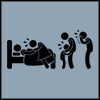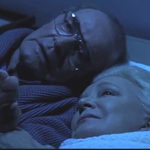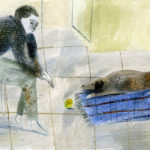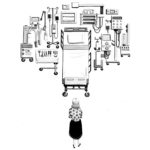 THOUGHTS ABOUT THE END
THOUGHTS ABOUT THE END
Articles
 Zen and the Art of Dying Well According to the National Institute of Health, 5 percent of the most seriously ill Americans account for more than 50 percent of health care spending, with most costs incurred in the last year of life in hospital settings. Economists call this a “cure at all cost” attitude. And in the next 25 years, longer life spans and the aging of baby boomers are expected to double the number of Americans 65 years or older, to about 72 million. What if the most promising way to fix the system is to actually do less for the dying? – The New York Times
Zen and the Art of Dying Well According to the National Institute of Health, 5 percent of the most seriously ill Americans account for more than 50 percent of health care spending, with most costs incurred in the last year of life in hospital settings. Economists call this a “cure at all cost” attitude. And in the next 25 years, longer life spans and the aging of baby boomers are expected to double the number of Americans 65 years or older, to about 72 million. What if the most promising way to fix the system is to actually do less for the dying? – The New York Times
 How to Talk About Dying I was 25 when I flew home for my father’s last birthday. His cancer had returned and he would die three months later at the age of 57. What I remember most about that weekend was the large rectangular gift box he opened. My mother had bought him a new suitcase. – The New York Times
How to Talk About Dying I was 25 when I flew home for my father’s last birthday. His cancer had returned and he would die three months later at the age of 57. What I remember most about that weekend was the large rectangular gift box he opened. My mother had bought him a new suitcase. – The New York Times
 Experts on Aging, Dying as They Lived At 10 years old I knew my parents did not wish to be resuscitated nor plugged into machines in the event of serious illness. They told me they were not afraid of death but rather of being kept alive at any cost. I knew they would refuse medical interventions, if they felt there was no purpose except to separate the dying from their deaths. They were wary of doctors who my parents said were trained by a medical culture that had lost touch with what should be its major focus: ending suffering. – The New York Times
Experts on Aging, Dying as They Lived At 10 years old I knew my parents did not wish to be resuscitated nor plugged into machines in the event of serious illness. They told me they were not afraid of death but rather of being kept alive at any cost. I knew they would refuse medical interventions, if they felt there was no purpose except to separate the dying from their deaths. They were wary of doctors who my parents said were trained by a medical culture that had lost touch with what should be its major focus: ending suffering. – The New York Times
 The Best Possible Day I spoke with more than 200 people about their experiences with aging or serious illness, or dealing with a family member’s — many of them my own patients, some in my own family. I interviewed and shadowed front-line staff members in old age homes, palliative- care specialists, hospice workers, geriatricians, nursing home reformers, pioneers, and contrarians. And among the many things I learned, here are the two most fundamental. – The New York Times
The Best Possible Day I spoke with more than 200 people about their experiences with aging or serious illness, or dealing with a family member’s — many of them my own patients, some in my own family. I interviewed and shadowed front-line staff members in old age homes, palliative- care specialists, hospice workers, geriatricians, nursing home reformers, pioneers, and contrarians. And among the many things I learned, here are the two most fundamental. – The New York Times
 On Dying After Your Time The dream of beating back time is an old one. Shakespeare had King Lear lament the tortures of aging, while the myth of Ponce de Leon’s Fountain of Youth in Florida and the eternal life of the Struldbrugs in “Gulliver’s Travels” both fed the notion of overcoming aging.– The New York Times
On Dying After Your Time The dream of beating back time is an old one. Shakespeare had King Lear lament the tortures of aging, while the myth of Ponce de Leon’s Fountain of Youth in Florida and the eternal life of the Struldbrugs in “Gulliver’s Travels” both fed the notion of overcoming aging.– The New York Times
 Weighing the End of Life One weekend last year, we asked our vet how we would know when it was time to put down Byron, our elderly dog. Byron was 14, half blind, partly deaf, with dementia, arthritis and an enlarged prostate. He often walked into walls, stood staring vacantly with his tail down, and had begun wandering and whining for reasons we could not always decipher. – The New York Times
Weighing the End of Life One weekend last year, we asked our vet how we would know when it was time to put down Byron, our elderly dog. Byron was 14, half blind, partly deaf, with dementia, arthritis and an enlarged prostate. He often walked into walls, stood staring vacantly with his tail down, and had begun wandering and whining for reasons we could not always decipher. – The New York Times
 End-of-Life Choices Should Be Clearly Mapped Robert H. Laws, a retired judge in San Francisco, and his wife, Beatrice, knew it was important to have health care directives in place to help their doctors and their two sons make wise medical decisions should they ever be unable to speak for themselves. With forms from their lawyer, they completed living wills and assigned each other as health care agents. – SF Gate
End-of-Life Choices Should Be Clearly Mapped Robert H. Laws, a retired judge in San Francisco, and his wife, Beatrice, knew it was important to have health care directives in place to help their doctors and their two sons make wise medical decisions should they ever be unable to speak for themselves. With forms from their lawyer, they completed living wills and assigned each other as health care agents. – SF Gate
 Taking Responsibility for Death I was standing by my 89-year-old mother’s hospital bed when she asked a doctor, “Is there anything you can do here to give me back the life I had last year when I wasn’t in pain every minute?” The young medical resident, stunned by the directness of the question, blurted out, “Honestly, ma’am, no.” And so Irma Broderick Jacoby went home and lived another year, during which she never again entered a hospital or subjected herself to an invasive, expensive medical procedure. – The New York Times
Taking Responsibility for Death I was standing by my 89-year-old mother’s hospital bed when she asked a doctor, “Is there anything you can do here to give me back the life I had last year when I wasn’t in pain every minute?” The young medical resident, stunned by the directness of the question, blurted out, “Honestly, ma’am, no.” And so Irma Broderick Jacoby went home and lived another year, during which she never again entered a hospital or subjected herself to an invasive, expensive medical procedure. – The New York Times
 Among Doctors, Fierce Reluctance to Let Go The conversation took place two years ago, but Dr. Daniel Matlock still recalls it quite vividly. You tend to remember when a physician colleague essentially brands you a Nazi. Dr. Matlock, a geriatrician who specializes in palliative care, had been called in to consult when a woman in her 70s arrived at the University of Colorado Hospital, unresponsive after a major stroke. – The New York Times
Among Doctors, Fierce Reluctance to Let Go The conversation took place two years ago, but Dr. Daniel Matlock still recalls it quite vividly. You tend to remember when a physician colleague essentially brands you a Nazi. Dr. Matlock, a geriatrician who specializes in palliative care, had been called in to consult when a woman in her 70s arrived at the University of Colorado Hospital, unresponsive after a major stroke. – The New York Times
 Imagine a Medicare ‘Part Q’ for Quality at the End of Lifes I spent the last Sunday of my father’s life sitting by his bed on the hospice unit in a small Connecticut hospital. He was dying of pneumonia, once called “the old man’s friend.” There was a nondenominational chapel down the hall, and a sheet cake in the kitchen. His hand was warm. Reassured by the quiet presence of the hospice nurses and feeling the mysterious quickening of life through his veins, I gave over to being his daughter and letting him be my father one last time. – The New York Times
Imagine a Medicare ‘Part Q’ for Quality at the End of Lifes I spent the last Sunday of my father’s life sitting by his bed on the hospice unit in a small Connecticut hospital. He was dying of pneumonia, once called “the old man’s friend.” There was a nondenominational chapel down the hall, and a sheet cake in the kitchen. His hand was warm. Reassured by the quiet presence of the hospice nurses and feeling the mysterious quickening of life through his veins, I gave over to being his daughter and letting him be my father one last time. – The New York Times
Other Organizations
Books
 Being Mortal by Atul Gawande Through eye-opening research and gripping stories of his own patients and family, Gawande reveals the suffering this dynamic has produced. Nursing homes, devoted above all to safety, battle with residents over the food they are allowed to eat and the choices they are allowed to make. Doctors, uncomfortable discussing patients’ anxieties about death, fall back on false hopes and treatments that are actually shortening lives instead of improving them.
Being Mortal by Atul Gawande Through eye-opening research and gripping stories of his own patients and family, Gawande reveals the suffering this dynamic has produced. Nursing homes, devoted above all to safety, battle with residents over the food they are allowed to eat and the choices they are allowed to make. Doctors, uncomfortable discussing patients’ anxieties about death, fall back on false hopes and treatments that are actually shortening lives instead of improving them.
 When Breath Becomes Air by Paul Kalanithi At the age of thirty-six, on the verge of completing a decade’s worth of training as a neurosurgeon, Paul Kalanithi was diagnosed with stage IV lung cancer. One day he was a doctor treating the dying, and the next he was a patient struggling to live. And just like that, the future he and his wife had imagined evaporated. When Breath Becomes Air chronicles Kalanithi’s transformation from a naive medical student “possessed,” as he wrote, “by the question of what, given that all organisms die, makes a virtuous and meaningful life” as a neurosurgeon at Stanford working in the brain, the most critical place for human identity, and finally into a patient and new father confronting his own mortality.
When Breath Becomes Air by Paul Kalanithi At the age of thirty-six, on the verge of completing a decade’s worth of training as a neurosurgeon, Paul Kalanithi was diagnosed with stage IV lung cancer. One day he was a doctor treating the dying, and the next he was a patient struggling to live. And just like that, the future he and his wife had imagined evaporated. When Breath Becomes Air chronicles Kalanithi’s transformation from a naive medical student “possessed,” as he wrote, “by the question of what, given that all organisms die, makes a virtuous and meaningful life” as a neurosurgeon at Stanford working in the brain, the most critical place for human identity, and finally into a patient and new father confronting his own mortality.

